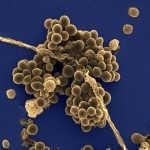Link to Pubmed [PMID] – 24904056
J. Biol. Chem. 2014 Jul;289(30):21003-21015
Streptococcus agalactiae (group B Streptococcus or GBS) is a common cause of invasive infections in newborn infants and adults. The ability of GBS to bind human fibrinogen is of crucial importance in promoting colonization and invasion of host barriers. We characterized here a novel fibrinogen-binding protein of GBS, designated FbsC (Gbs0791), which is encoded by the prototype GBS strain NEM316. FbsC, which bears two bacterial immunoglobulin-like tandem repeat domains and a C-terminal cell wall-anchoring motif (LPXTG), was found to be covalently linked to the cell wall by the housekeeping sortase A. Studies using recombinant FbsC indicated that it binds fibrinogen in a dose-dependent and saturable manner, and with moderate affinity. Expression of FbsC was detected in all clinical GBS isolates, except those belonging to the hypervirulent lineage ST17. Deletion of fbsC decreases NEM316 abilities to adhere to and invade human epithelial and endothelial cells, and to form biofilm in vitro. Notably, bacterial adhesion to fibrinogen and fibrinogen binding to bacterial cells were abolished following fbsC deletion in NEM316. Moreover, the virulence of the fbsC deletion mutant and its ability to colonize the brain were impaired in murine models of infection. Finally, immunization with recombinant FbsC significantly protected mice from lethal GBS challenge. In conclusion, FbsC is a novel fibrinogen-binding protein expressed by most GBS isolates that functions as a virulence factor by promoting invasion of epithelial and endothelial barriers. In addition, the protein has significant immunoprotective activity and may be a useful component of an anti-GBS vaccine.

